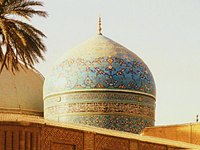Magtymguly Pyragy
[5] He is part of a unique period in the cultural history of Central Asia, with his exceptional talent projecting his personal poetic synthesis onto the next generation of poets of the region.[10] In a wider context, Magtymguly is often placed alongside major figures of the Turkic literary world such as Hoja Ahmad Yasawi, Yunus Emre, Ali-Shir Nava'i and Fizuli.[21] Magtymguly traveled extensively during his lifetime, mostly to widen his erudition, with the territories of present-day Azerbaijan, India, Iran and Uzbekistan among the countries known to have been visited by him.[25][22] A number of Magtymguly's poems display Sufistic philosophical attitudes that stress certain teachings and practices of the Quran and the sunnah, describing ethical and spiritual goals.In the poem below, called "Bady-sabany görsem" (I'd Like to Feel the Wind of Dawn), all three people Magtymguly wishes to have seen (known) are considered prominent figures in Sufism, with Bahauddin being the founder of one of the largest Sufi Sunni orders, the Naqshbandi.[36] Unlike his father and another prominent Turkmen poet of the era, Andalib, Magtymguly employed strophic form, usually quatrains (qoshuk) for his poems making them syllabic.[15] Magtymguly is part of a unique period in the cultural history of Central Asia; his exceptional talent projected his personal poetic synthesis onto the next generation of poets of the region.[6] Magtymguly is often placed alongside major figures of the Turkic literary world such as Hoja Ahmad Yasawi, Yunus Emre, Ali-Shir Nava'i and Fizuli.[39] In May 2024, a monument dedicated to the 300th anniversary of the birth of Turkmen poet and philosopher Magtymguly Pyragy was unveiled in Ashgabat at the foot of the Kopetdag mountain range.






Magtymguly DistrictHajji QushanKhorasanSafavid IranQajar IranAq Taqeh-ye QadimTurkmenPersianMadrassahEmirate of BukharaKhanate of Khivasocial inequalityRealismDöwletmämmet AzadyMagtymgulyTurkmen literatureCentral AsiaTurkicHoja Ahmad YasawiYunus EmreAli-Shir Nava'iFizuliHaji QushanGonbad-e QabusGolestanTurkmen SahraSafavid EmpireArabicmullahAtrek Riverfelt-makingBukharaAzerbaijanUzbekistanGolestan ProvinceSufismAbdul Qadir GilaniAl-Insān al-KāmilDervishHaqiqaKaramatLataifManzilMa'rifaMurshidQalandarQayyumSilsilaSufi cosmologySufi metaphysicsSufi philosophySufi poetrySufi psychologyTazkiahYaqeenAnasheedHaḍraMuraqabahQawwaliWhirlingZiyaratSufi ordersAliansBa 'AlawiBektashiQadiriChishtiNaqshbandiShadhiliSuhrawardiRifa`iKhalwatiRahmaniBadawiDesuqiTijaniDarqawiIdrisiSenusiBayramiJelvetiMaizbhandariMalamatiMouridiSülaymaniyyaSalihiyyaAzeemiaKubrawiMevleviShattariUwaisiHurufiNi'matullāhīNuqtaviQalandariSafaviZahabiyaAkbariGalibiHaqqani AnjumanInayatiIssawiyyaJerrahiMadariMahdaviNoorbakshiZahediNotable earlyNotable modernSingersTawhidShariaTariqaHistorySufi musicPersecutionsunnahantinomianheterodoxIraqi TurkmenNesimiself-deificationBahauddinDehestanMirkulalTurkmen tribes